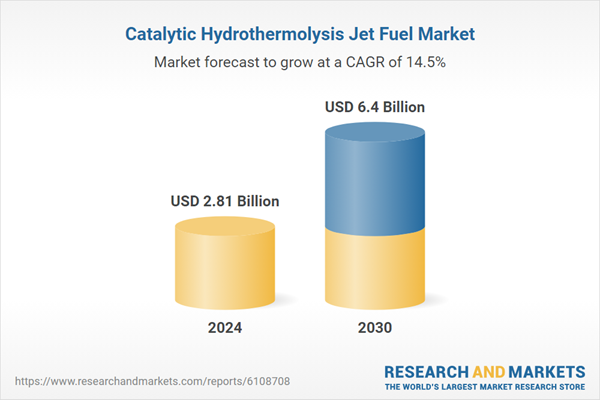Speak directly to the analyst to clarify any post sales queries you may have.
10% Free customizationThis report comes with 10% free customization, enabling you to add data that meets your specific business needs.
Key Market Drivers
Rising Aviation Sector Emissions and Decarbonization Commitments
The CHJ market is being driven by growing urgency to cut carbon emissions in aviation - a sector accounting for approximately 2.5% of global CO₂ emissions. Without intervention, aviation emissions could triple by 2050. The International Air Transport Association (IATA) and over 130 countries under the ICAO Long-Term Aspirational Goal have pledged to achieve net-zero emissions by 2050, prompting adoption of SAFs like CHJ.CHJ fuels can reduce lifecycle CO₂ emissions by up to 80% and function as drop-in replacements for conventional Jet-A, eliminating the need for aircraft or infrastructure modifications. Policy mandates such as the EU's ReFuelEU, requiring 2% SAF by 2025 and 70% by 2050, are intensifying demand. Additionally, major airlines have secured long-term offtake agreements for over 15 billion liters of SAF. These factors collectively position CHJ as a scalable and policy-aligned solution in global aviation decarbonization strategies.
Key Market Challenges
High Capital and Operational Costs
One of the primary challenges for the CHJ market lies in the high capital and operating costs associated with building and running production facilities. The process demands advanced high-temperature, high-pressure equipment, corrosion-resistant materials, and substantial energy inputs. Construction of a single CHJ facility may require investments in the hundreds of millions of dollars, limiting entry to well-capitalized firms or those with government backing. Operational costs are further elevated by feedstock preprocessing and hydrogen usage during upgrading.Currently, CHJ production costs remain 2-4 times higher than fossil-based jet fuels, making competitiveness an issue in price-sensitive markets. Moreover, the reliance on region-specific subsidies introduces financial risk. Geographical constraints linked to feedstock and hydrogen sourcing also limit deployment flexibility. These factors pose significant hurdles to commercial scalability, especially in emerging markets. Addressing these cost barriers through technological improvements and stable offtake contracts is critical to unlocking broader market potential.
Key Market Trends
Strategic Collaborations Between Technology Providers and Refiners
A key trend shaping the CHJ market is the increasing collaboration between technology developers, refiners, and engineering firms aimed at accelerating commercialization. CHJ technology, though proven, requires substantial investment and integration expertise. Strategic partnerships help bridge technical gaps, reduce risk, and streamline project execution.For example, Applied Research Associates (ARA), originator of the CH process, has licensed its CH Jet® technology through a collaboration with Chevron Lummus Global (CLG), enabling turn-key implementation solutions. Similarly, Aemetis is developing a 90 million gallon-per-year CHJ facility in California, supported by engineering partnerships and offtake agreements. These alliances also aid in securing feedstock supplies, qualifying for carbon credits, and retrofitting existing refineries to lower capital requirements. Through shared investment and operational synergies, such partnerships are pivotal to scaling CHJ production and expanding its market footprint.
Key Market Players
- Aemetis, Inc.
- Applied Research Associates, Inc.
- Neste Oyj
- Chevron Lummus Global
- World Energy
- Gevo, Inc.
- Honeywell UOP
- LanzaJet
- SkyNRG
- Fulcrum BioEnergy
Report Scope:
In this report, the Global Catalytic Hydrothermolysis Jet Fuel Market has been segmented into the following categories, in addition to the industry trends which have also been detailed below:Catalytic Hydrothermolysis Jet Fuel Market, By Feedstock Type:
- Used Cooking Oil
- Animal Fats
- Tallow
- Algae
- Others
Catalytic Hydrothermolysis Jet Fuel Market, By Technology:
- Pure Catalytic Hydrothermolysis Process
- CH Integrated with HEFA
- CH + Fischer-Tropsch Synthesis
Catalytic Hydrothermolysis Jet Fuel Market, By Application:
- Commercial Aviation
- Military Aviation
- Cargo Aviation
- Private & Business Aviation
Catalytic Hydrothermolysis Jet Fuel Market, By Region:
- North America
- United States
- Canada
- Mexico
- Europe
- Germany
- France
- United Kingdom
- Italy
- Spain
- South America
- Brazil
- Argentina
- Colombia
- Asia-Pacific
- China
- India
- Japan
- South Korea
- Australia
- Middle East & Africa
- Saudi Arabia
- UAE
- South Africa
Competitive Landscape
Company Profiles: Detailed analysis of the major companies present in the Global Catalytic Hydrothermolysis Jet Fuel Market.Available Customizations:
With the given market data, the publisher offers customizations according to a company's specific needs. The following customization options are available for the report.Company Information
- Detailed analysis and profiling of additional market players (up to five).
This product will be delivered within 1-3 business days.
Table of Contents
Companies Mentioned
- Aemetis, Inc.
- Applied Research Associates, Inc.
- Neste Oyj
- Chevron Lummus Global
- World Energy
- Gevo, Inc.
- Honeywell UOP
- LanzaJet
- SkyNRG
- Fulcrum BioEnergy
Table Information
| Report Attribute | Details |
|---|---|
| No. of Pages | 185 |
| Published | July 2025 |
| Forecast Period | 2024 - 2030 |
| Estimated Market Value ( USD | $ 2.81 Billion |
| Forecasted Market Value ( USD | $ 6.4 Billion |
| Compound Annual Growth Rate | 14.5% |
| Regions Covered | Global |
| No. of Companies Mentioned | 10 |









